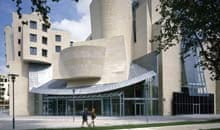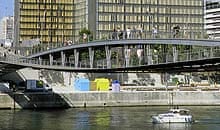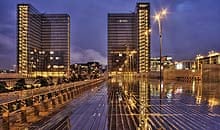Baron Haussmann has a lot to answer for. While his mid-19th-century re-ordering of the French capital made Paris one of the most beautiful cities in the world, it can also be crushingly regular and uniform. No matter whether you're in the swanky 16th arrondissement, or the grimy 20th, the six storey, balconied blocks of apartments are astonishingly samey.
And despite the "Big Bang" of the Grand Projets in the 1980s – the pyramid in the centre of the Louvre, the hole-punched-out La Grande Arche in La Defense – things have been rather quiet of late in the French capital. While "starchitects" such as Foster, Rodgers and Hadid throw up buildings in London, Vienna and Berlin, Paris has somehow missed out on the all the fun.
But all is not lost – here are four buildings, all do-able within a day, three within walking distance of each other, that can match anything more cutting edge cities have to offer.
French Communist Party Headquarters
Possibly Paris' architectural gem, and best-kept secret, the national HQ for the Parti Communiste Français (PCF) was designed by Oscar Niemeyer, the centagenarian Brazilian who created the entire capital city of Brasilia from scratch.
This is one of his rare European works. Constructed between 1967 and 1972 in the then working-class district of the 19th arrondissement, it has a sinuous brown-glazed façade, and tell-tale concrete support pillars. The apparent upturned white saucer on the forecourt – reminiscent of Niemeyer's work for the parliament building in Brasilia – is the real give-away though. This is, in fact, the ceiling of the underground central debating chamber of the communist party; and probably one of the most magical and breathtaking internal spaces in Europe.
Inside, the walls are all curved. As are the sliding electric doors to gain entry. Light is diffused through thousands of steel squares that hang from the ceiling, while brown leather chairs all face the white concrete podium at the front. It is – to use a non-technical architectural expression – straight out of 2001: A Space Odyssey. And best of all, it's free and open to the public.
The central chamber is not the only room worth seeing – the sloping concrete entrance foyer, the rooftop café and the other meeting rooms are all worth a look, but ask nicely as the party officials can be a bit paranoid – this is a working political party office, after all.
(For Niemeyer aficionados, he also designed the HQ of the communist party newspaper, L'Humanité, in the northern suburb of St Denis, and the Job Centre in Bobigny, north-east Paris).
· Parti Communiste Français, 2 Place Colonel Fabien, Metro Colonel Fabien, Open Mon-Fri 10am-4pm,
Cinémathèque Francaise

The Frank Gehry-designed new national film centre couldn't be further away, physically or design-wise, from its famous old base in the Trocadero, overlooking the Eiffel Tower (immortalised in the Bernardo Bertolucci film The Dreamers, it had a key role in the 1968 uprising 40 years ago).
The new building is in the Seine-side district of Bercy, in Paris' south-east, which mayor Bertrand Delanoë is pushing as a new urban "village". Gehry's design, finished in 1994 (and so three years before his more famous Bilbao Guggenheim), was actually for an entirely different client, the American Centre, and its conversion into a cinema and educational complex is far from perfect.
On the two street sides of the building, Gehry's limestone and zinc building is fairly unobtrusive, fitting with the height and context of the Haussmann street plan. On the two sides facing a park, however, Gehry's trademark "collapsing-cubist" style comes into play, albeit in a restrained way (Gehry compared it to a "dancer lifting her tutu").
Although the four-screen facility is state of the art for cinemaphiles, the out-of-the-way location (and lack of a bar!) make for something of a soulless experience for cinema-goers - although it's still exciting for architecture-buffs!
· Cinémathèque Francaise, 51 rue de Bercy, Metro Bercy. Open to the public midday-10pm. Closed Tuesdays
Passerelle Simone de Beauvoir

Across the Parc de Bercy from the Cinémathèque Francaise is Paris' answer to London's Millennium Bridge – and a very graceful riposte it is, too.
At 300m long, the pedestrian and cyclist footbridge designed by Austrian Dietmar Feichtinger links the two banks of the Seine, but (unlike it's British equivalent) slopes off into an upper and lower deck, thus providing shelter in the centre of the river for walkers in the rain, and an eye-like aperture when seen in cross-section.
The materials are similar, wood and steel, and while the Paris bridge probably lacks London's "blade-of-steel" profile, it has a curvaceous, lolloping form to it, which, when crossing, feels a little like being on an old wooden rollercoaster.
Named after the French feminist thinker, and opened in 2006 by mayor Betrand Delanoë, the bridge's disembarkation on to the south bank deliberately pierces the new François Mitterrand Bibliothèque Nationale in a most phallic manner – no doubt de Beauvoir would have approved!
· Footbridge Simone de Beauvoir, Metros Bercy or Quai de la Gare. Open day and night
Bibliothèque Nationale de France

President François Mitterrand commissioned the national library as his final "grand projet", after a difficult start this gigantic library is starting to show its quality.
Designed by French architect Dominique Perrault and opened in 1996, the building – four vertical towers shaped like open books, demarcating the corners of the site – is very conceptual and 1960s-esque, but the materials and quality are pure1990s.
Arriving from the de Beauvoir footbridge, one is confronted with a pyramid-like mountain of steps leading to an elevated plaza, bookended (pardon the pun) by the towers. Two long external escalators then take the reader down into a sunken garden, with a beautiful, if slightly mysterious, artificially planted forest (the reading rooms all look out on to the trees, giving them an incredible tranquillity in the middle of the city, but there is no public access). The towers themselves are simply for book storage, all the public space is subterranean.
While there are some impracticalities (it can be a long walk to the toilets from the reading room) and the towers had to have shutters added to protect the books from the light, the building is becoming recognised as a subtly crafted delight.
· Bibliothèque François Mitterand, open daily 9-7pm, except Sunday and Monday mornings. Metro François Mitterrand
